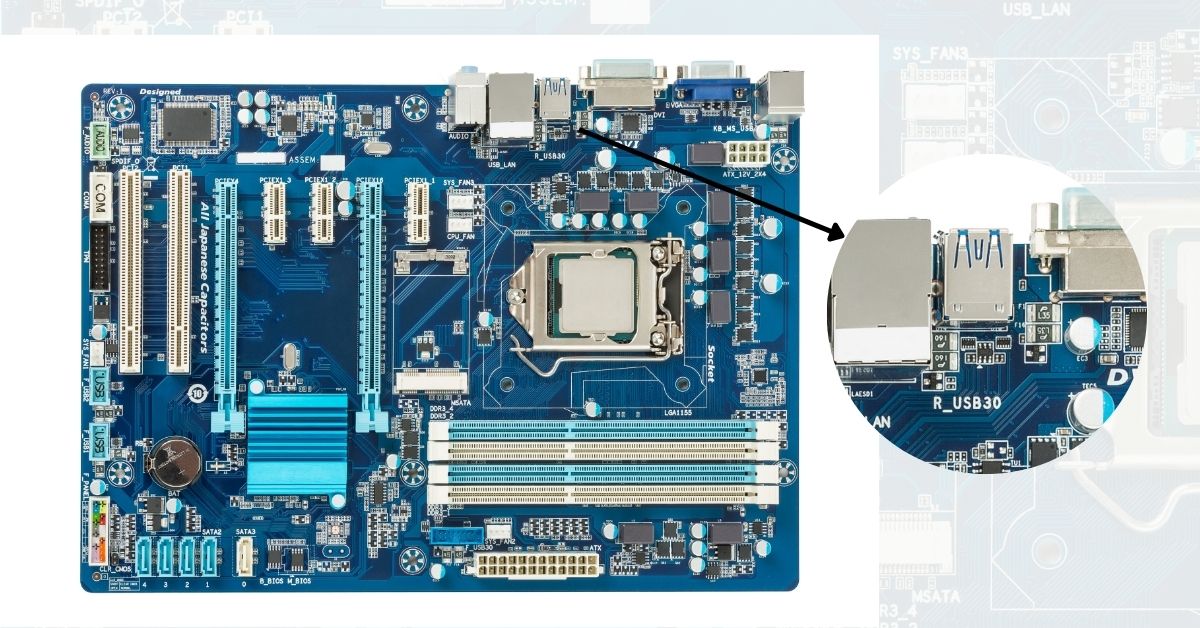USB is a standard that has been around for a while, but you may have seen that USB 3.0 is becoming more ubiquitous. So where is the USB 3.0 port on the motherboard and what is it used for?
USB 3.0 is usually located on the edge of the motherboard. It is the newer, faster standard designed to handle much higher speeds and power usage compared to USB 2.0. USB 3.0 devices will still work in USB 2.0 ports but you won’t get as much capacity out of them.
Let’s look at the differences between the standards, how they work and where to find them physically on the motherboard.
Where to Plug In USB 3.0 on Motherboard?
The USB capabilities have expanded over time since its release in 1996. Starting with USB 1.0, it has seen large increases particularly in data speed or transfer rate.
This can mean that if you plug the USB 3.0 or higher into the wrong USB port, it may not get the full speed or have compatibility, sometimes failing to work at all.
USB, standing for Universal Serial Bus, is generally going to be located on the edge of the motherboard, and consists of a black plastic header that includes male, metal connectors pointing upwards, to slot into the holes in the cable.

As these headers or connectors look identical, you’ll want to examine the board itself carefully as right above the USB headers, there will be an identifier written to show which is which.
The general way for a USB 3.0 port will be ‘USB3_1_2’, with the first number, 3, being used to denote that it is indeed a USB 3.0 port, and the 1 meaning it is the first connector, and 2 denoting the second connector, meaning you can have two USB 3.0 outputs.
This piece of information will always be located in the motherboard’s manual, so be sure to reference that. You can easily find your manual on the manufacturer’s website. The model will be written on the motherboard itself.
Otherwise, if you can boot into Windows, open up the Run command and type in DxDiag, and the first screen that shows System Information should have your motherboard name listed under System Model.
What Is USB 3.0 Used for on a Motherboard?
USB 3.0 offers faster data transfer speeds, and to a lesser extent it allows higher power consumption by devices requiring such. USB 3.0 is also useful for certain fast charging applications.
USB 3.0 has certain technological advancements over older versions of USB, such as bidirectional data transfer.
This means that USB 3.0 is going to be better in almost all use cases than USB 2.0 or USB 1.0.
Are USB 2.0 and 3.0 Ports the Same?
USB 2.0 and USB 3.0 are the same dimensions, meaning that a USB 2.0 or lower device can still be plugged into a USB 3.0 device.
USB 3.0 are distinguishable by their blue colored inserts or pins, and sometimes will even have the writing 3.0 or similar on them. USB 2.0 tends to be white or black on the inside.
The different USB standards also have different internal wiring, as USB 2.0 has a total of four connector wires. USB 3.0 instead has a total of nine connector wires, which enables the previously mentioned bidirectional data transfer.
USB 2.0 speed tops out at 480 megabits/s (60MB/s), which reveals its original concept as allowing the connection of peripherals such as keyboards, mice or headsets.
However, with the rise in use of USB as a data transfer medium, you’ll get around 10 times faster transfers than USB 2.0 going to around 5 Gigabit/s (625MB/S).
What Happens if You Plug a USB 3.0 Into a USB 2.0 Port?
A USB 3.0 compatible device will still work when plugged into a USB 2.0 port. You won’t be able to get the USB 3.0 speeds on such a device, however.
They are meant to be backwards compatible in a sense, to allow devices only with USB 2.0 ports to still be used, if slightly inefficiently as you won’t get the full speed.


